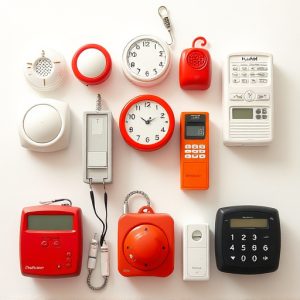Rechargeable Vs Battery Personal Alarms: Features & Safety Comparison
Personal distress signals are vital for self-preservation, with early recognition allowing individua…….
Personal distress signals are vital for self-preservation, with early recognition allowing individuals to take proactive measures. Rechargeable personal alarms offer a modern solution, providing continuous power and versatility with adjustable volumes, diverse sounds, and LED flashlights. While traditional battery-powered alarms offer instant protection and loud sounds, their lifespan is limited by battery capacity. The choice between rechargeable and battery-powered alarms depends on individual needs, balancing convenience against long-term sustainability. Both types serve as essential tools for safety and peace of mind in the Rechargeable Vs Battery Personal Alarms market.
In today’s world, understanding personal distress signals is paramount for safety, especially in remote or risky environments. These signals can be lifesavers, but choosing the right alarm—rechargeable vs. battery-powered—is crucial. This article delves into the intricacies of personal distress signals, exploring when and why they matter. We compare rechargeable and battery alarms, highlighting their features, benefits, reliability, and durability. Understanding these differences enables folks to make informed decisions, ensuring they’re prepared for any situation.
- Understanding Personal Distress Signals: When and Why They Matter
- Rechargeable Personal Alarms: Features and Benefits
- Battery-Powered Personal Alarms: Reliability and Durability
- Comparatively Analyzing Rechargeable vs. Battery Alarms for Safety
Understanding Personal Distress Signals: When and Why They Matter
Personal distress signals, often triggered by a range of physical and emotional factors, are vital tools for self-preservation and safety. These signals can manifest as sudden changes in behavior, intense emotions, or specific bodily sensations that indicate an individual is in distress. Understanding these cues is crucial, especially when considering the wide array of personal alarms available, such as those powered by rechargeable batteries or traditional battery sources.
Recognizing personal distress signals early on enables individuals to take proactive measures for their well-being. In emergency situations, these signals can provide critical time for help to arrive. For example, someone experiencing a panic attack might exhibit rapid breathing, increased heart rate, and sweating, all of which are distinct physical responses that can be recognized as distress signals. Similarly, changes in behavior like sudden aggression or withdrawal could indicate underlying emotional turmoil requiring attention. Whether relying on rechargeable vs battery personal alarms, being attuned to these signals is essential for effective self-protection and prompt response in times of need.
Rechargeable Personal Alarms: Features and Benefits
In the ongoing quest for personal safety, rechargeable personal alarms stand out as a modern and sustainable alternative to traditional battery-powered devices. Unlike their single-use counterparts, these alarms offer the advantage of being continuously powered, ensuring they’re always ready when needed. Each alarm is equipped with a portable charging cable, allowing users to top up their device easily at home or on the go. This feature proves invaluable in situations where quick access and reliability are paramount.
One significant benefit of rechargeable personal alarms over battery-operated ones is cost-effectiveness in the long run. While initial investment might be higher, the ability to recharge eliminates the recurring expense of purchasing new batteries. Moreover, these devices often incorporate advanced features such as adjustable volumes, various alarm sounds, and even LED flashlights, making them versatile tools for diverse emergency scenarios.
Battery-Powered Personal Alarms: Reliability and Durability
Battery-powered personal alarms are a popular choice for individuals seeking immediate protection and attention in emergencies. These devices rely on standard batteries to operate, offering a straightforward and readily available solution. However, when comparing them to their rechargeable counterparts, there’s an ongoing debate regarding reliability and durability.
While traditional battery alarms provide instant activation and loud sounds to deter potential threats, their lifespan is ultimately limited by the battery’s capacity. In contrast, rechargeable personal alarms offer a more sustainable option. They eliminate the need for frequent battery replacements, ensuring consistent protection over extended periods. This makes them particularly advantageous for outdoor enthusiasts, travelers, or individuals in remote areas who require reliable distress signals without worrying about battery depletion.
Comparatively Analyzing Rechargeable vs. Battery Alarms for Safety
When it comes to personal distress signals, choosing between rechargeable and battery-powered alarms can significantly impact safety. Both options offer critical protection, but they differ in key areas. Battery alarms are immediate and reliable, requiring no charging, making them ideal for quick deployment scenarios or places with unstable power sources. However, they may require more frequent replacement, which can be a drawback over time.
Rechargeable alarms, on the other hand, offer cost-effectiveness and environmental friendliness due to reduced battery waste. They can be charged and reused, making them a sustainable choice. Yet, they might not always be readily available for use if power is cut off or during power outages. Despite these differences, both rechargeable vs. battery personal alarms serve as valuable tools for ensuring safety and peace of mind.
In the pursuit of personal safety, understanding and utilizing distress signals equipped with tracking capabilities is paramount. This article has explored two primary types: rechargeable and battery-powered personal alarms. By examining their features, benefits, and drawbacks, we’ve highlighted the importance of making an informed choice between rechargeable vs battery-powered alarms to ensure reliability and peace of mind in emergency situations. Ultimately, selecting the right alarm can be a game-changer when it comes to navigating through distressing scenarios.


